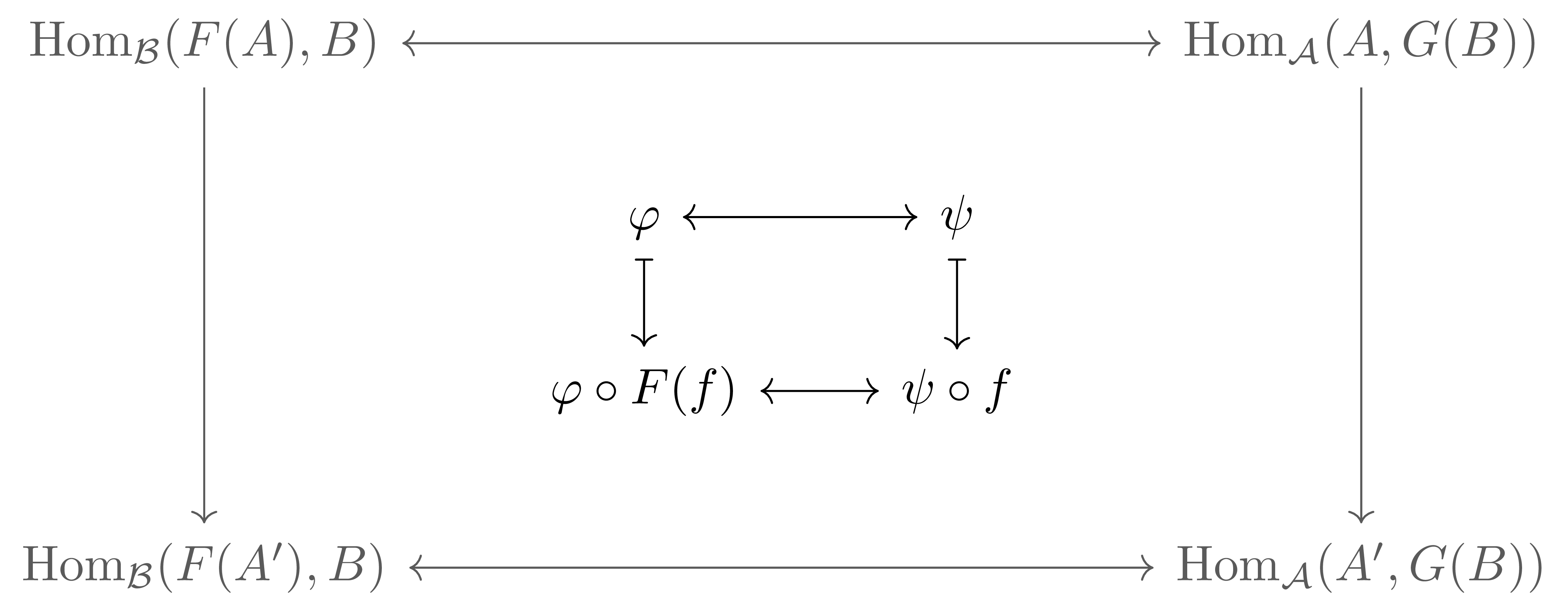이번 글에서 우리는 adjoint functor들에 대해 살펴본다. 이들은 범주론에서만 배울 경우 다소 비자명해보일 수도 있지만, 다양한 분야들에서의 예시를 통해 매우 중요한 개념임을 알 수 있다.
수반함자의 정의
우선 정의부터 시작한다.
정의 1 두 functor $F: \mathcal{A}\rightarrow \mathcal{B}$, $G: \mathcal{B}\rightarrow \mathcal{A}$가 주어졌다 하고, 두 variable $A,B$에 대해 natural한 다음의 isomorphism
\[\Hom_\mathcal{B}(F(A), B)\cong \Hom_\mathcal{A}(A, G(B))\]이 주어졌다면, 이 pair $(F,G)$를 adjunction수반쌍이라 부르고, $F$를 $G$의 left adjoint왼쪽 수반함자, $G$를 $F$의 right adjoint오른쪽 수반함자라 부른다. 이를 $F\dashv G$로 표기한다.
예시 2 임의의 preordered set $(S,\preceq)$는 항상 category로 생각할 수 있었다. (§범주, ⁋예시 3) 이 category의 morphism은 정확히 preorder $\preceq$와 같으므로, 두 preordered set $S,S’$을 category로 본다면 이들 사이의 functor $F:S \rightarrow S’$는 그냥 집합 $S$에서 $S’$로의 증가함수에 불과하다.
그럼 두 functor $F: S \rightarrow S’$와 $G:S’ \rightarrow S$에 대하여 $F\dashv G$라는 것은 다음 식
\[F(x)\preceq y\iff x\preceq G(y)\]이 성립하는 것이다. 즉, 이들은 monotone Galois connection을 이룬다. ([집합론] §필터와 아이디얼, 갈루아 대응, ⁋정의 6)
Unit과 counit
이제 다음 adjunction

이 주어졌다 하자. $\mathcal{A}$의 대상 $A$를 고정하고 나면, 정의 1의 isomorphism에 의하여 다음 functor
\[\Hom_\mathcal{A}(A, G-): \mathcal{B}\rightarrow\Set\]은 representable functor이며, natural isomorphism
\[\Hom_\mathcal{A}(A, G-)\cong\Hom_\mathcal{B}(F(A), -)\]이 functor의 representation이 된다. 한편 §표현가능한 함자, ⁋정리 3에 의하여, 우리는 $\Hom_\mathcal{B}(F(A),-)$에서 $\Hom_\mathcal{A}(A,G-)$로의 natural transformation $\alpha$는 항상 $\alpha_{F(A)}(\id_{F(A)})$의 원소에 의해 결정된다는 것을 안다. 즉 우리 상황에서 위의 natural isomorphism은 $\Hom_\mathcal{A}(A, GF(A))$의 원소 $\eta_A$에 의해 결정되며, 우리는 위의 isomorphism의 naturality로부터 이 모임 $(\eta_A)_{A\in\obj(\mathcal{A})}$이 $\id_\mathcal{A}$에서 $GF$로의 natural transformation을 정의한다는 것을 안다. 이를 이 adjunction의 unit이라 부른다. 비슷하게 $\mathcal{B}$의 대상 $B$를 고정하는 것으로 시작하여 얻어지는 natural transformation $\epsilon:FG \rightarrow \id_\mathcal{B}$를 이 adjunction의 counit이라 부른다.
거꾸로 임의의 두 natural transformation $\eta:\id_\mathcal{A}\Rightarrow GF$, $\epsilon: FG\Rightarrow\id_\mathcal{B}$가 존재하여 다음 triangle identity들

을 만족한다면, 이것이 정확히 정의 1의 adjunction과 같은 정보를 갖고 있다는 것이 알려져 있다.
Free functor와 forgetful functor
예시 3에서 살펴볼 adjunction을 살펴보기 위해서 우리는 우선 forgetful functor가 무엇인지를 간단히 설명한다. §범주, ⁋예시 2에서 우리는 기존에 알고 있던 많은 수학적인 구조들은 각자의 category를 이룬다는 것을 살펴보았다. 그런데 이 예시들을 보면, 어떤 수학적인 구조는 다른 수학적인 구조에 추가적인 데이터를 주는 것으로 얻어진다. 가령 monoid는 집합 $S$에 결합법칙을 만족하는 이항연산과 항등원에 대한 정보를 추가하여 얻어지는 것이며, 이 이항연산이 역원까지 갖는다면 group이 된다. 거꾸로 말하자면, group $G$는 항상 monoid로 생각할 수도 있고, monoid $M$은 항상 집합으로 생각할 수도 있다. 이 예시들이 functor $\Grp \rightarrow\Mon$과 $\Mon \rightarrow \Set$을 정의한다는 것을 확인할 수 있다. 이러한 종류의 functor들을 forgetful functor라 부른다.
예시 3 (Free $\dashv$ Forgetful) 적당한 두 category $\mathcal{A},\mathcal{B}$와 forgetful functor $U: \mathcal{A}\rightarrow \mathcal{B}$가 주어졌다 하자. 그럼 $U$의 left adjoint $F:\mathcal{B}\rightarrow \mathcal{A}$가 존재한다면 이를 free functor라 부른다. 이는 다음 식
\[\Hom_\mathcal{A}(F(A),B)\cong\Hom_\mathcal{B}(A, U(B))\]이 성립한다는 의미이다.
- Forgetful functor $U:\Grp \rightarrow \Set$의 left adjoint $F:\Set \rightarrow \Grp$이 존재한다. 임의의 집합 $X$에 대해 $F(X)$를 free group자유군이라 부른다.
- Forgetful functor $U:\Ab \rightarrow \Set$의 left adjoint $F:\Set \rightarrow \Ab$이 존재한다. 임의의 집합 $X$에 대해 $F(X)$를 free abelian group자유아벨군이라 부른다.
Enriched category / internal hom
반변수반함자
한편, 지금까지는 covariant functor에 대한 adjoint functor들만 생각하고 있었는데, contravariant functor들에 대해서도 adjoint functor들이 잘 정의된다.
정의 4 Contravariant functor $F:\mathcal{A} \rightarrow \mathcal{B}$와 $G: \mathcal{B}\rightarrow \mathcal{A}$가 주어졌다 하자. 그럼 두 variable $A,B$에 대해 natural한 다음의 isomorphism
\[\Hom_\mathcal{B}(F(A), B)\cong\Hom_\mathcal{A}(G(B), A)\]이 존재한다면 이들이 mutually left adjoint라 한다. 비슷하게, 만일 두 variable $A,B$에 대해 natural한 다음의 isomorphism
\[\Hom_\mathcal{B}(B, F(A))\cong\Hom_\mathcal{A}(A, G(B))\]이 존재한다면 이들이 mutually right adjoint라 한다.
이중수반함자
한편 우리는 adjoint functor의 개념을 여러개의 변수에 대해서도 확장할 수 있다.
우선 bifunctor $F: \mathcal{A}\times \mathcal{B}\rightarrow \mathcal{C}$를 생각하자. 그럼 $\mathcal{A}$의 대상 $A$를 고정하고 나면 functor
\[F(A,-):\mathcal{B}\rightarrow \mathcal{C}\]를 얻는다. 이렇게 정의된 $F(A,-)$가 right adjoint $G_A: \mathcal{C}\rightarrow \mathcal{B}$를 갖는다고 가정하자. 즉 다음 식
\[\Hom_\mathcal{B}(B, G_A(C))\cong \Hom_\mathcal{C}(F(A, B), C)\tag{1}\]이 성립한다. 비슷한 논증이 $F(-,B):\mathcal{A}\rightarrow \mathcal{C}$으로 시작했어도 얻어진다. 다음의 명제 5는 이러한 right adjoint가
이번 글에서는 다뤄야 할 내용이 많아서 다음 명제를 증명하지는 않지만, 위의 식 (1)에 naturality를 부여하기 위해서는 $G$가 $\mathcal{A}^\op\times \mathcal{C}\rightarrow \mathcal{B}$여야 한다는 것을 알 수 있다. 만일 $A’ \rightarrow A$가 주어진다면 $F(A’,B)\rightarrow F(A,B)$가 주어지고 따라서 우변은 $\Hom_\mathcal{C}(F(A’,B),C)$가 되는 반면, 좌변에서는 $A$가 포함된 항이 $\Hom_\mathcal{B}$의 target 부분에 있기 때문이다.
명제 5 Bifunctor $F: \mathcal{A}\times \mathcal{B}\rightarrow \mathcal{C}$를 고정하자.
-
만일 모든 $A$에 대해 $F(A,-):\mathcal{B}\rightarrow \mathcal{C}$가 right adjoint $G_A$를 갖는다면, 이들을 모아 유일한 bifunctor $G:\mathcal{A}^\op\times \mathcal{C}\rightarrow \mathcal{B}$를 만들어서, 다음의 isomorphism
\[\Hom_\mathcal{C}(F(A,B),C)\cong\Hom_\mathcal{B}(B, G(A,C))\]이 세 variable들에 대해 모두 natural하도록 할 수 있다.
-
만일 모든 $B$에 대해 $F(-,B):\mathcal{A}\rightarrow \mathcal{C}$가 right adjoint $H_A$를 가지고, 따라서 위의 결과에 의해 bifunctor $H:\mathcal{B}^\op\times \mathcal{C}\rightarrow \mathcal{A}$가 정의된다면, 두 natural isomorphism
\[\Hom_\mathcal{C}(F(A,B),C)\cong\Hom_\mathcal{B}(B, G(A,C))\]그리고
\[\Hom_\mathcal{C}(F(A,B),C)\cong\Hom_\mathcal{A}(A, H(B,C))\]에서 우변에 있는 두 contravariant functor $G(-,C): \mathcal{B} \rightarrow \mathcal{C}$와 $H(-,C):\mathcal{A}\rightarrow \mathcal{C}$는 mutually right adjoint이다.
이 명제를 통해, bifunctor가 관련되어있는 adjunction을 어떤 식으로 정의해야하는지 추측할 수 있다.
정의 6 Bifunctor들
\[F: \mathcal{A}\times \mathcal{B}\rightarrow \mathcal{C},\quad G: \mathcal{A}^\op\times \mathcal{C}\rightarrow \mathcal{B},\quad H:\mathcal{B}^\op\times \mathcal{C}\rightarrow \mathcal{A}\]이 주어졌다 하자. 그럼 세 variable들에 대해 모두 natural한 다음의 isomorphism
\[\Hom_\mathcal{C}(F(A,B), C)\cong \Hom_\mathcal{B}(B, G(A, C))\cong\Hom_\mathcal{A}(A, H(B, C))\]이 존재한다면 이를 two-variable adjunction이라 부른다.
만일 $\mathcal{A}=\mathcal{B}=\mathcal{C}$이고 $F:\mathcal{A}\times \mathcal{A}\rightarrow \mathcal{A}$가 monoidal product 구조를 준다면 $G,H$를 각각 $F$의 left, right closure라 부른다. 또, $G,H$가 isomorphic하다면 $F$를 closed라 부른다.
예시 7 특별히 cartesian monoidal category $(\Set,\times)$을 생각하자. (§모노이드 범주, ⁋예시 6) 그럼 다음의 isomorphism ([집합론] §집합의 곱, ⁋명제 4)
\[\Hom_\Set(A\times B, C)\cong\Hom_\Set(A,\Hom_\Set(B,C))\cong\Hom_\Set(B,\Hom_\Set(A,C))\]이 각 성분에 대해 natural하다는 것을 알 수 있다. 뿐만 아니라 left closure와 right closure가 모두 $\Hom_\Set(-,-)$로 동일하므로 $\Set$은 cartesian closed category이다.
Internal $\Hom$
예시 6에서 우리는 bifunctor $\Hom_\Set$을 $\times$에 대한 right adjoint로 해석할 수 있었다. 이를 일반화하여 monoidal category에서 다음과 같이 정의한다.
정의 8 Symmetric monoidal category $(\mathcal{A},\otimes)$가 주어졌다 하자. 그럼 $\mathcal{A}$에서의 internal $\Hom$은 bifunctor $[-,-]:\mathcal{A}^\op\times \mathcal{A}\rightarrow \mathcal{A}$로서, 임의의 대상 $A\in\obj(\mathcal{A})$에 대해 다음의 adjunction
\[(-\otimes A)\dashv [A,-]\]이 성립하는 것이다. Internal $\Hom$이 존재하는 symmetric monoidal category를 closed symmetric monoidal category라 부른다.
Internal $\Hom$의 예시는 앞으로 천천히 살펴보게 될 것이지만, 우선 정의만 보더라도 기존의 $\Hom$과 다른 점을 찾을 수 있다. 일반적으로 (locally small) category에서 $\Hom$을 취하는 것은 bifunctor
\[\Hom_\mathcal{A}(-,-):\mathcal{A}^\op\times \mathcal{A}\rightarrow \Set\]을 주지만, internal $\Hom$의 경우 이 bifunctor의 target category가 $\Set$이 아니라 $\mathcal{A}$ 자기 자신이 되므로 훨씬 풍부한 정보를 담고 있을 것이다. 더 일반적으로 target category를 임의의 closed symmetric monoidal category로 바꾸어주면 enriched category의 개념을 얻는다.
Limit과 adjoint
마지막으로, 역시 증명을 하지 않는 다음의 정리를 소개한다.
정리 9 Adjunction $F\dashv G$가 주어졌다 하자. 그럼
- $F$는 colimit을 보존한다.
- $G$는 limit을 보존한다.
참고문헌
[Rie] Emily Riehl. Category Theory in Context. Dover Publications, 2016.

댓글남기기